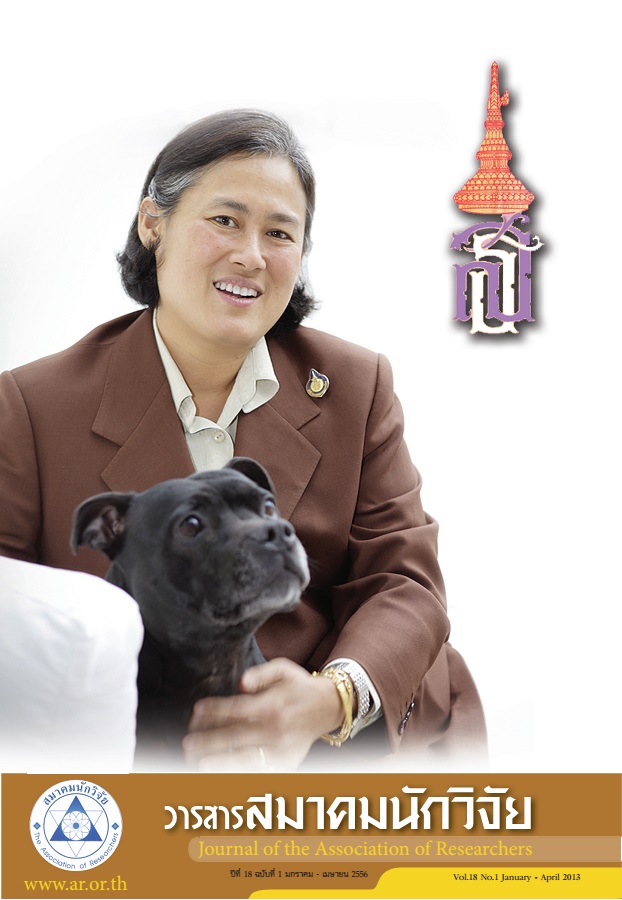Impact of Soybean Cake Tariff Reduction on Soybean Industry in Thailand
Main Article Content
Abstract
Soybean is an important feed crop. However, the production of Soybean and soybean cake are not sufcient for consumption and domestic industry's demand. Under WTO, Thailand has to liberalize the markets of soybean and soybean cake. Since 1997, they have been imported without quota restriction but still have been imposed tariff 0 percent on soybean and 5 percent on soybean cake and have been reduced later to 4 percent in 2005. It indicates that government has opened freely trade for soybean but has still implemented a tariff barrier for soybean cake. This study investigates the effects of reduc ing tariff for soybean on stakeholder of soybean industry and net social welfare. A partial equilibrium of multi-market model and OLS and 3SLS estimation methods are conducted. The results exhibit soybean oil crushing factory, soybean farmer, egg farmer and consumer of chicken and pork are worse-off. On the other hand, feed producer, soybean oil consumer, chicken and swine producer, and egg consumer are better-off. Tariff revenue decreases. Therefore, tariff for soybean cake should be maintained for improving the domestic social welfare.
Article Details
บทความที่ปรากฏในวารสารนี้ เป็นความรับผิดชอบของผู้เขียน ซึ่งสมาคมนักวิจัยไม่จำเป็นต้องเห็นด้วยเสมอไป การนำเสนอผลงานวิจัยและบทความในวารสารนี้ไปเผยแพร่สามารถกระทำได้ โดยระบุแหล่งอ้างอิงจาก "วารสารสมาคมนักวิจัย"
References
จิราพร ประสานวรรณ. (2540), ผลกระทบข้อผูกพันการนําเข้ากากถั่วเหลืองของเอเปคต่ออุตสาหกรรมไก่เนื้อของ ประเทศไทย. วิทยานิพนธ์วิทยาศาสตรมหาบัณฑิต สาขาเศรษฐศาสตร์เกษตร, มหาวิทยาลัยเกษตรศาสตร์
ชุติมา โสภิตกุล. (2533), การวิเคราะห์นโยบายการนําเข้ากากถั่วเหลืองของประเทศไทย: ศึกษาทางด้านสวัสดิการ วิทยานิพนธ์วิทยาศาสตรมหาบัณฑิต สาขาเศรษฐศาสตร์เกษตร, มหาวิทยาลัยเกษตรศาสตร์
นิทรา อาลัยเวช. (2534), ผลกระทบของนโยบายการนําเข้ากากถั่วเหลืองต่อตลาดกากกากถั่วเหลือง ตลาดเมล็ด ถั่วเหลือง และตลาดเนื้อสัตว์, วิทยานิพนธ์ศิลปศาสตรมหาบัณฑิต สาขาเศรษฐศาสตร์ มหาวิทยาลัย ธรรมศาสตร์
รัชนีพร ธิติทรัพย์. (2534), การวิเคราะห์ผลกระทบของนโยบายภาษีเสริมต่อการนําเข้ากากถั่วเหลืองของประเทศไทย วิทยานิพนธ์วิทยาศาสตรมหาบัณฑิต สาขาเศรษฐศาสตร์เกษตร, มหาวิทยาลัยเกษตรศาสตร์,
ศุภวรรณ นิลกําแหง. (2544). การวิเคราะห์ดุลยภาพบางส่วนของผลกระทบจากการลดภาษีภายใต้ข้อตกลงองค์การ การค้าโลกต่ออุตสาหกรรมถั่วเหลืองไทย. วิทยานิพนธ์วิทยาศาสตรมหาบัณฑิต สาขาเศรษฐศาสตร์ เกษตร, มหาวิทยาลัยเกษตรศาสตร์,
Issariyanukula, A. (1980). An Econometric Analysis of the Supply and Demend for Soybeans in Thailand. Doctor of Philosophy Thesis in Agricultural Economics, Washington State University.
Charinkan, P. (1992). The Government Intervention on Soybean Industry of Thailand. Master of Economics Thesis, Thammasat University.
Erwidodo & Hadi, P. U. (1999). “Impact of trade liberalization on agriculture in Indonesia:Commodity aspects.” The CGPRT Centre Working Paper, Series 48, 36-48.
Houck, J. P. (1964). “A statistical model of the demand for soybeans.” Journal of Farm Economics, 46(2), 366-374.
Houck, J. P., Ryan, M. E., & Subotnik, A. (1972). Soybeans and Their Products: Markets, Models, and Policy. Minneapolis: University of Minnesota Press.
Itharattana, K. (1999). “Impact of trade liberalization on agriculture in Thailand: Commodity aspects.” The CGPRT Centre Working Paper, Series 49, 39-55.
Janssen, W. (1992). "Welfare calculations in a distributed lag model: Beans in Columbia.” Canadian Journal of Agricultural Economics, 40(3), 459-474.
Just, R. E., Hueth, D. L., & Schmitz, A. (2004). The Welfare Economics of Public Policy: A Practical Approach to Project and Policy Evaluation. Cheltenham: Edward Elgar.
Koo, W. W., & Kennedy, P. L. (2005). International Trade and Agriculture. Malden.: Blackwell.
Knipscheer, H. C., Hill, L. D., & Dixon, B. L. (1982). “Demand elasticities for soybean meal in the European community.” American Journal of Agricultural Economics, 64(2), 249-253.
Nerlove, M. (1958). The Dynamics of Supply: Estimation of Farmers' Response to Price. Baltimore: Johns Hopkins.
Nicholson, W. (2005). Microeconomic Theory: Basic Principles and Extensions. (9th ed.). Mason: Thomson/South-Western.
Persaud, S. C., & Chern, W. S. (2002). "Meat trade liberalization and soybean-rapeseed competition in
the Japanese market.” Journal of Agribusiness, 20(1), 67-83.
Reed, M. R. (2001). International Trade in Agricultural Products. New Jersey.: Prentice-Hall.
Sayaka, B., Sumaryanto, A., Croppenstedt & DiGiuseppe, S. (2007). An Assessment of the Impact of Higher Yields for Maize, Soybean and Cassava in Indonesia: A Multi-Market Model Approach.Retrieved April 8, 2010, rom http://www.fao.org/ex/esa.
Seesai, P. (1997). Demand and Supply Analysis of Soybean and Soybean Products in Thailand.Doctor of Philosophy Thesis in Agricultural Economics, Kasetsart University.
Varian, H. R. (1992). Microeconomic Analysis. (3rd ed.). New York: Norton.
Woo, R. J., Calkins, P. H., & Meyers, W. H. (1986). Soybean Import Demand in Taiwan: Economics Growth and Policy Impacts. Retrieved April 8, 2010, from http://www.card.iastate.edu/publications/DBS/PDFFiles/86wp8.pdf.
Zhao, X., Mullen, J., & Grifth, G, 2005). Economic Surplus Measurement in Multi-Market Models Retrieved April 8, 2010, fromhttp://www..ageconsearch.umn.edu/bitstream/12910/1/wp050003. pdf.


